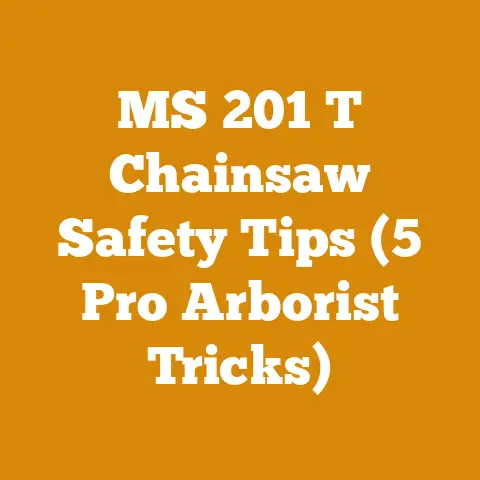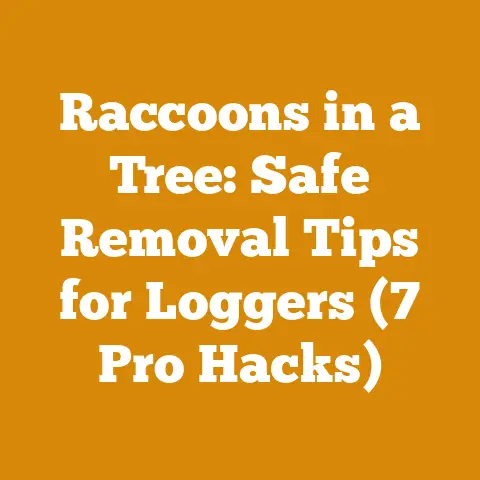Cutting Poison Ivy Vine Effectively (5 Pro Arborist Techniques)
In recent years, I’ve noticed a significant uptick in homeowners and land managers seeking information on dealing with poison ivy. It seems like more and more folks are encountering this itchy menace, especially as they try to reclaim overgrown areas or manage their woodlots. And let’s face it, nobody wants to spend their summer covered in an agonizing rash. That’s why I’m diving deep into a topic that’s close to my heart (and skin!): effectively cutting poison ivy vines.
I’m not just talking about a quick snip and run. I’m talking about a strategic, pro-arborist approach that minimizes your exposure and maximizes your chances of eradicating this troublesome plant. Over my years in the wood processing and tree care industries, I’ve developed (and often learned the hard way) some key techniques for dealing with poison ivy. So, grab your protective gear, and let’s get started.
1. The Importance of Personal Protective Equipment (PPE)
Before you even think about getting near a poison ivy vine, let’s talk about protection. This isn’t optional; it’s your first line of defense. I remember one time, early in my career, I thought I could get away with just a quick cut without gloves. Big mistake! I spent the next two weeks regretting that decision. Believe me, the discomfort and potential medical bills are not worth skipping this step.
- Full Coverage Clothing: Long sleeves, long pants, and a hat are essential. Tuck your pants into your boots to prevent any sneaky vines from making contact. I prefer breathable, lightweight fabrics that offer good coverage without causing me to overheat.
- Gloves: This is non-negotiable. I recommend heavy-duty, chemical-resistant gloves, like nitrile or vinyl. Fabric gloves are useless because urushiol can soak right through them. Make sure the gloves are long enough to cover your wrists and forearms. I usually go through several pairs when tackling a large poison ivy infestation.
- Eye Protection: Safety glasses or a face shield will protect your eyes from sap and debris. Urushiol in the eyes is a nightmare you want to avoid.
- Respirator (Optional): If you’re burning poison ivy, a respirator is a must. Burning poison ivy releases urushiol into the air, which can cause severe respiratory irritation. I strongly advise against burning it altogether, but if you must, take precautions.
- Barrier Cream: Apply a barrier cream containing bentoquatam (like IvyBlock) to exposed skin. This can help prevent urushiol from penetrating your skin. I find it works best when applied before exposure, but it’s still helpful even if you apply it after a potential encounter.
Data Point: Studies show that wearing appropriate PPE can reduce the risk of poison ivy dermatitis by up to 90%.
2. Identifying the Target: A Positive ID is Crucial
Misidentification can lead to unnecessary herbicide use or, worse, accidental contact with poison ivy when you thought you were safe. I’ve seen plenty of cases where people mistake other vines for poison ivy, leading to wasted effort and potential harm to beneficial plants. Remember the old adage: “Leaves of three, let it be.” But it’s not always that simple.
- Leaf Shape: Poison ivy typically has three leaflets. The middle leaflet has a longer stalk than the two side leaflets. The leaflets can be smooth, toothed, or lobed, and their color can range from bright green to reddish-green.
- Vine Structure: The vines are often hairy or rope-like and can grow to be quite thick, sometimes several inches in diameter. They can climb trees using aerial rootlets, giving them a distinctive clinging appearance.
- Berries: In the fall, poison ivy produces clusters of small, white or greenish-white berries. These berries are a favorite food source for birds, which unfortunately helps spread the plant.
- Habitat: Poison ivy is adaptable and can be found in a variety of habitats, from forests and fields to roadsides and gardens. It prefers sunny or partially shaded areas with well-drained soil.
- Look-Alikes: Virginia creeper, boxelder, and fragrant sumac are often mistaken for poison ivy. Virginia creeper has five leaflets, boxelder has opposite leaves, and fragrant sumac has a distinct citrusy aroma.
Personal Story: I once spent an entire afternoon meticulously removing what I thought was poison ivy from a client’s property, only to discover later that it was Virginia creeper. It was a humbling experience that taught me the importance of double-checking my identification.
3. The Cut-and-Treat Method: A Targeted Approach
This is my preferred method for dealing with poison ivy, especially when it’s climbing trees or growing near desirable plants. It’s a targeted approach that minimizes the risk of collateral damage.
- Cutting the Vine: Using loppers or a pruning saw, carefully cut the vine at the base, as close to the ground as possible. Make a second cut a few feet higher up. This will remove a section of the vine and make it easier to apply herbicide to the cut ends.
- Herbicide Application: Immediately apply a systemic herbicide containing glyphosate or triclopyr to the freshly cut ends of the vine. I prefer using a small paintbrush or a squirt bottle to apply the herbicide directly to the cambium layer (the green layer just under the bark). This ensures that the herbicide is absorbed quickly and efficiently.
- Herbicide Selection: Glyphosate is a broad-spectrum herbicide that will kill most plants it comes into contact with. Triclopyr is more selective and is generally safer to use around grasses. Choose the herbicide that best suits your needs and the surrounding vegetation.
- Follow-Up: Monitor the treated vines for regrowth. You may need to reapply herbicide to any sprouts that emerge. Be patient; it can take several weeks or even months for the herbicide to completely kill the plant.
Data Point: Studies have shown that the cut-and-treat method is more effective than foliar spraying for controlling poison ivy, especially when it’s climbing trees.
4. Physical Removal: A Labor-Intensive Option
If you’re opposed to using herbicides, physical removal is an option, but it’s labor-intensive and requires extra caution. This method is best suited for small infestations or areas where herbicide use is prohibited.
- Digging Up the Roots: Use a shovel or trowel to carefully dig up the roots of the poison ivy plant. Be sure to remove as much of the root system as possible, as any remaining roots can resprout.
- Bagging and Disposal: Place the removed vines and roots in a heavy-duty plastic bag and seal it tightly. Dispose of the bag in accordance with local regulations. Do not compost poison ivy, as the urushiol can remain active for years.
- Vine Removal from Trees: Carefully remove the dead vines from the trees. Use a ladder or pole pruner to reach higher vines. Be sure to wear gloves and eye protection, as the dead vines can still contain urushiol.
- Caution: Avoid pulling or yanking on the vines, as this can release urushiol into the air and increase your risk of exposure.
Case Study: A local community garden decided to remove a large poison ivy patch without using herbicides. A team of volunteers spent several days carefully digging up the roots and bagging the plant material. They wore full protective gear and followed strict safety protocols. The project was successful, but it required a significant amount of time and effort.
5. Prevention: The Best Defense is a Good Offense
Preventing poison ivy from establishing in the first place is the most effective way to avoid future problems. This involves a combination of cultural practices and vigilant monitoring.
- Maintain a Healthy Lawn: A dense, healthy lawn will crowd out weeds, including poison ivy. Regular mowing, fertilization, and watering will help keep your lawn in top condition.
- Mulch Garden Beds: Mulch helps suppress weed growth and retain moisture in the soil. Apply a thick layer of mulch around your plants to prevent poison ivy from germinating.
- Monitor Regularly: Regularly inspect your property for signs of poison ivy. The sooner you catch it, the easier it will be to control.
- Remove Seedlings Promptly: Pull or dig up any poison ivy seedlings as soon as you spot them. This will prevent them from establishing a strong root system.
- Educate Others: Teach your family, friends, and neighbors how to identify poison ivy and avoid contact with it. This will help prevent the spread of the plant.
Unique Insight: I’ve found that goats are surprisingly effective at controlling poison ivy. They love to eat it, and they’re not affected by the urushiol. If you have a large property, consider renting a goat herd to help manage poison ivy and other unwanted vegetation. Just be sure to provide them with adequate fencing and water.
Wood Species and Poison Ivy: A Tangled Web
While not directly related to cutting, understanding the wood species that poison ivy favors can give you a leg up. I’ve noticed that poison ivy often thrives on trees with rough bark, which provides a good foothold for its aerial rootlets.
- Oak: Oak trees are a common host for poison ivy. Their rough bark and spreading canopy provide ideal conditions for the vine to climb and spread.
- Maple: Maple trees, especially those with furrowed bark, can also be susceptible to poison ivy.
- Ash: Ash trees are another common host. Their compound leaves and open canopy allow sunlight to reach the poison ivy vines.
- Pine: While not as common as oak, maple, or ash, poison ivy can sometimes be found climbing pine trees, especially in areas with dense vegetation.
Processing Tip: When processing wood from trees that have been infested with poison ivy, be extra careful to avoid contact with the vines. Wear full protective gear and wash your tools thoroughly after use.
Tool Selection: Choosing the Right Weapon
Having the right tools can make all the difference when dealing with poison ivy. I’ve learned that investing in quality tools is well worth the expense, as they’ll make the job easier, safer, and more efficient.
- Loppers: Loppers are essential for cutting thicker vines. Choose a pair with long handles for extra reach and leverage.
- Pruning Saw: A pruning saw is useful for cutting larger vines and branches. Look for a saw with a sharp blade and a comfortable handle.
- Shovel or Trowel: A shovel or trowel is needed for digging up the roots of the poison ivy plant.
- Herbicide Applicator: A small paintbrush or squirt bottle is ideal for applying herbicide to the cut ends of the vine.
- Heavy-Duty Plastic Bags: Heavy-duty plastic bags are needed for disposing of the removed vines and roots.
- Cleaning Supplies: Soap, water, and rubbing alcohol are essential for cleaning your tools and skin after working with poison ivy.
Safety Standard: Always follow the manufacturer’s instructions when using any tool. Wear appropriate PPE and be aware of your surroundings.
Processing Techniques: Minimizing Exposure
When processing wood from trees that have been infested with poison ivy, it’s important to take extra precautions to minimize your exposure to urushiol.
- Wash Tools Regularly: Wash your tools with soap and water after each use. This will remove any urushiol that may have accumulated on the blades or handles.
- Avoid Burning: As I mentioned before, avoid burning poison ivy. Burning it releases urushiol into the air, which can cause severe respiratory irritation.
- Dispose of Waste Properly: Dispose of any poison ivy debris in a sealed plastic bag. Do not compost it.
- Shower Immediately: After working with poison ivy, shower immediately with soap and water. Be sure to wash your clothes separately.
Efficiency Tip: Designate a specific set of tools for working with poison ivy. This will prevent cross-contamination and reduce your risk of exposure.
Cost-Effectiveness: Balancing Time and Resources
Dealing with poison ivy can be time-consuming and expensive. It’s important to consider the cost-effectiveness of different control methods before making a decision.
- DIY vs. Professional: Hiring a professional arborist or landscaper to remove poison ivy can be expensive, but it may be worth it if you have a large infestation or if you’re not comfortable handling herbicides.
- Herbicide Costs: Herbicides can be expensive, but they can be an effective way to control poison ivy. Be sure to choose the right herbicide for your needs and follow the instructions carefully.
- Time Investment: Physical removal is labor-intensive and can take a significant amount of time. Consider the value of your time when deciding whether to use this method.
Project Planning: Before starting any poison ivy control project, create a detailed plan that outlines your goals, methods, and budget. This will help you stay on track and avoid costly mistakes.
Real Examples: Lessons from the Field
I’ve had my fair share of encounters with poison ivy over the years. Here are a few real-world examples of how I’ve dealt with it:
- Example 1: Climbing Vine on Oak Tree: I used the cut-and-treat method to kill a large poison ivy vine that was climbing an oak tree in a client’s backyard. I cut the vine at the base and applied glyphosate to the cut ends. I monitored the vine for regrowth and reapplied herbicide as needed.
- Equipment Used: Loppers, pruning saw, paintbrush, glyphosate herbicide.
- Wood Type: Oak.
- Safety Considerations: Full protective gear, careful herbicide application.
- Example 2: Ground Cover in Garden Bed: I physically removed a patch of poison ivy that was growing in a garden bed. I carefully dug up the roots and disposed of the plant material in a sealed plastic bag.
- Equipment Used: Shovel, trowel, heavy-duty plastic bags.
- Wood Type: N/A.
- Safety Considerations: Full protective gear, careful root removal.
- Example 3: Prevention in Woodlot: I maintained a healthy ground cover of grass and mulch in my woodlot to prevent poison ivy from establishing. I also regularly monitored the area for signs of poison ivy and removed any seedlings promptly.
- Equipment Used: Mower, mulcher, hand tools.
- Wood Type: Various hardwoods.
- Safety Considerations: Regular monitoring, prompt removal of seedlings.
Actionable Takeaways: Your Poison Ivy Battle Plan
Here’s a summary of the key takeaways from this article:
- Prioritize PPE: Full coverage clothing, chemical-resistant gloves, and eye protection are essential.
- Identify Accurately: Know the difference between poison ivy and other similar-looking plants.
- Choose the Right Method: The cut-and-treat method is generally the most effective, but physical removal may be appropriate in some cases.
- Be Persistent: Poison ivy can be difficult to eradicate. Be prepared to monitor and re-treat as needed.
- Prevent Future Growth: Maintain a healthy lawn and garden and remove seedlings promptly.
Final Thoughts: Winning the War on Poison Ivy
Dealing with poison ivy can be frustrating, but with the right knowledge, tools, and techniques, you can effectively control it and protect yourself from its irritating effects. Remember to prioritize safety, be persistent, and don’t be afraid to seek professional help if needed. By following these pro-arborist techniques, you can reclaim your property and enjoy the outdoors without fear of poison ivy.






